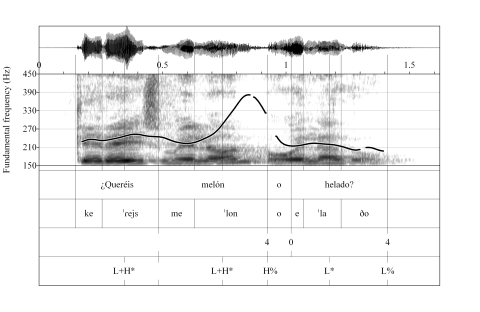Break indices of level 4 (BI 4) correspond to the end of major prosodic units: they mark the boundaries of intonational phrases (IPs).
There are some phenomena which may appear within an intonational phrase (IP) but not accross different IPs. So, on the one hand, a BI 4 inhibits the application of many sandhi rules. On the other hand, a BI 4 is accompanied by rhythmic cues: it is the domain for pre-boundary lengthening, and it defines the position for pauses. Finally, it has a precise intonational definition. The IP is the domain of the minimal tune: it consists of one or more pitch accents plus boundary tones. Thus, a BI 4 is always accompanied by the presence of boundary tones.
Example
¿Queréis melón, o helado?
[Do you want some melon, or ice cream?]

In this example, there are three prosodic words: Queréis, melón, and o helado assembled in two intonational phrases (IP): Queréis melón and o helado. The first IP contains two ips: there is a small prosodic rupture between Queréis and melón, which have to be separated by a BI 3. But the break after melón is perceived stronger, and is followed by a small pause. Moreover, the H% boundary tone at the right edge of Queréis melón makes pitch reach 390 Hz, which is a pretty high level in the tessiture of this speaker: the boundary tone is fully realized. So, the boundary between Queréis melón and o helado has to be labelled as BI 4. Obviously, the end of the sentence is the end of an IP, so it also has to be labelled BI 4.
- To see how to discriminate between BI 3 and BI 4: click here
